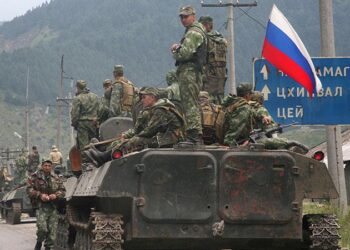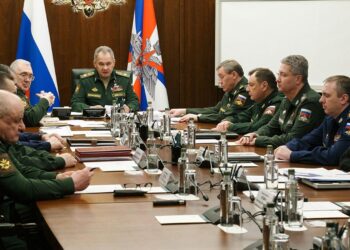Estonia, a small Baltic nation long regarded as a model of digital innovation and democratic resilience, has recently found itself at the center of escalating geopolitical tensions. As global powers vie for influence in Eastern Europe, Estonia’s strategic position-and its robust cybersecurity infrastructure-have placed it squarely in Washington’s crosshairs. This article examines the multifaceted challenges facing Estonia today, from Russian aggression and hybrid threats to the growing pressure for deeper transatlantic cooperation, highlighting why this Baltic state has become a critical front line in the broader contest for security and stability in the region.
Estonia’s Strategic Position in the Geopolitical Landscape
Positioned at the northeastern frontier of the European Union and NATO, this small Baltic nation plays an outsized role in the ongoing struggle for influence between Western powers and Russia. Estonia’s access to the Baltic Sea and proximity to St. Petersburg makes it a critical listening post and surveillance hub against potential Eastern aggression. The country’s robust digital infrastructure and pioneering cybersecurity initiatives have transformed it into an indispensable partner for intelligence sharing and defensive coordination, particularly vital in an era defined by hybrid warfare and cyber threats.
Estonia’s geopolitical significance is further underscored by its dynamic relationships and strategic alliances:
- Close cooperation with Nordic countries enhances regional security and economic integration.
- Membership in NATO’s Enhanced Forward Presence acts as a tangible deterrent against military provocations.
- Leading role in the EU Digital Single Market positions Estonia at the forefront of technological innovation impacting geopolitical stability.
| Factor | Impact on Strategy | Regional Influence |
|---|---|---|
| Geographic Location | Border Security, Naval Access | Baltic Stability |
| Cyber Capabilities | Defense & Intelligence | EU & NATO Digital Shield |
| Military Alliances | Collective Defense | Deterrence |
Challenges Facing Estonia Amid Rising Regional Tensions
Estonia finds itself navigating a precarious geopolitical landscape as regional tensions escalate. The country’s strategic position along NATO’s eastern flank exposes it to a spectrum of security threats, ranging from cyberattacks to conventional military provocations. Compounding these challenges is the persistent threat of misinformation campaigns aimed at undermining Estonia’s political stability and social cohesion. The resilience of its digital infrastructure is being tested, with repeated attempts to disrupt critical services reflecting broader hybrid warfare tactics in the region.
Economically, Estonia faces vulnerabilities linked to its dependence on trade routes and supply chains that are increasingly disrupted by neighboring conflicts. Energy security remains a pressing concern, as the nation’s limited domestic resources make it heavily reliant on imports susceptible to geopolitical leverage. Key challenges include:
- Cybersecurity threats targeting government institutions and private sectors.
- Political pressure from more dominant regional actors intent on expanding their influence.
- Economic instability prompted by disrupted trade and changing energy landscapes.
- Public trust erosion due to disinformation and propaganda campaigns.
| Category | Impact | Estonia’s Response |
|---|---|---|
| Cybersecurity | Frequent attacks on infrastructure | Investment in advanced defense systems |
| Energy Dependence | Reliance on imported fossil fuels | Development of renewable energy projects |
| Political Influence | Pressure from neighboring powers | Strengthening NATO alliances |
| Information Warfare | Growing disinformation campaigns | Media literacy programs & monitoring |
Policy Recommendations for Strengthening Estonia’s Security and Alliances
To fortify Estonia against evolving geopolitical threats, it is imperative to deepen its integration within NATO and cultivate resilient bilateral partnerships. Enhanced intelligence sharing with key allies, including the United States and Nordic countries, should be prioritized to detect and counter hybrid threats effectively. Investments aimed at upgrading cyber defense infrastructure will safeguard critical national assets, while expanded joint military exercises can improve operational interoperability and rapid response capacity across the region.
Strategic initiatives to consider:
- Establish a centralized command for coordinating hybrid warfare and cyber defense efforts
- Increase defense spending to meet and exceed NATO’s 2% GDP guideline within five years
- Expand Estonia’s role in regional intelligence hubs focused on Eastern Europe
- Promote defense innovation by supporting local cybersecurity startups through government grants
| Policy Area | Current Status | Recommended Action |
|---|---|---|
| Cybersecurity | Robust but underfunded | Increase annual budget by 30% |
| Military Readiness | NATO-aligned, limited resources | Expand joint drills and procure advanced tech |
| International Alliances | Strong NATO presence, growing Nordic ties | Formalize intelligence sharing agreements |
Insights and Conclusions
As Estonia continues to assert its strategic importance amid rising geopolitical tensions, the nation remains firmly in the crosshairs of larger powers vying for influence in the region. Washington’s careful calibration of support and deterrence will be critical in shaping not only Estonia’s future but also the broader security landscape of Eastern Europe. As developments unfold, the world will be watching closely to see how this small Baltic state navigates the complex challenges ahead.
















